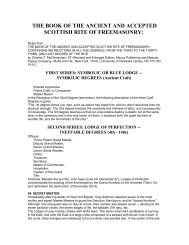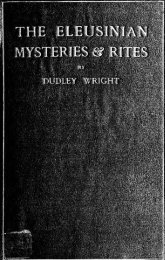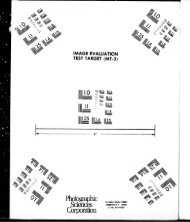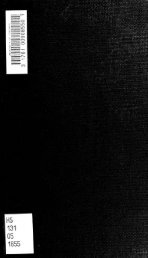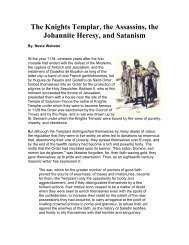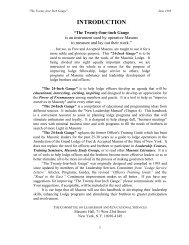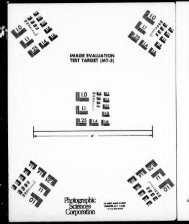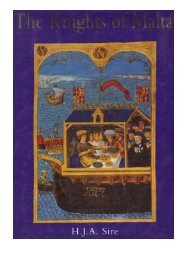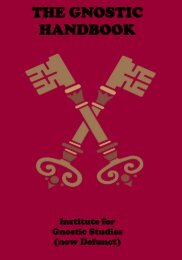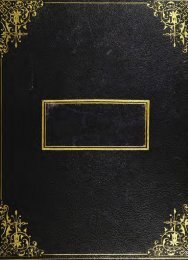Scottish Rite Masonry Illustrated - The Masonic Trowel
Scottish Rite Masonry Illustrated - The Masonic Trowel
Scottish Rite Masonry Illustrated - The Masonic Trowel
Create successful ePaper yourself
Turn your PDF publications into a flip-book with our unique Google optimized e-Paper software.
438 SUBLIME PRINCE OF TilE ROYAL SECRE’~.<br />
U.~. <strong>The</strong> Black Ox. <strong>The</strong> Ark and Palm Trees,<br />
Applying these devices to the five degrees, 1 7th, 18th,<br />
19th, 20th and 21st degrees, the Lion and Key would<br />
seem to be appropriate enough to the 21st degree, or<br />
the Grand Master of the Key of <strong>Masonry</strong>.<br />
<strong>The</strong> crowned double-headed Eagle, which is the arms<br />
of Prussia, to the 20th degree, or the Noachites or<br />
Prussian Knights.<br />
<strong>The</strong> Ark of the Covenant, of which the High Priest<br />
had the especial charge, to the 19th degree or Grand<br />
Pontiff and Master ad Vitam.<br />
<strong>The</strong> inflamed winged heart, emblematical of the sufferings<br />
and glory of the Master from Nazareth, to the<br />
18th degree, or Sovereign Prince of Rose Croix, and the<br />
an Egyptian and Jewish symbol, displayed on one<br />
of the Standards of the four principal tribes to the<br />
17th degree, or Jewish Knights of the East and West.<br />
It is likely that these devices have a still deeper<br />
meaning and a mysterious reference to an ancient religion<br />
and its mysteries, but we have, as to this, ourselves<br />
succeeded in obtaining but a few hints, and we<br />
can therefore communicate no more to you. <strong>The</strong>y will<br />
perhaps, give you the key to the esoteric meaning of<br />
these symbols and you cannot do better than to occupy<br />
your time and eiercise your intellect in discover,n~<br />
that meaning.<br />
<strong>The</strong> Ancient Persian~’ mysteries were sacred to the<br />
Note 2SS,—”From the statement of this Persian Mason it appear.<br />
that nearly all the members of the Persian Court belong to Ihe mystic<br />
Order, even as German <strong>Masonry</strong> enjoys the honor of counting the emperor<br />
and crown prince among its adherents <strong>The</strong> appearance of this Mohammedan<br />
Mason in Berlin seems to have excited a little surprise among<br />
some of the brethren there, and the surprise would he natural enough<br />
to persona not aware of the extent to which <strong>Masonry</strong> has been diffused<br />
o,er the earth. Account for It as one may. the truth is certain that th”<br />
mysterious Order was established in ihe Orient many ages ago. Neatly<br />
sil of the old Mohammedan buildings in India. anch as tomhs. mosques.<br />
etc., are marked with the <strong>Masonic</strong> symbols, and many of these structures,<br />
atlil perferct, were huilt in the time of the Mogul Km ror Akhar. who<br />
died in 1605. Thus <strong>Masonry</strong> must have been intrc,duceA”into india freEs<br />
Middle,. Asia by the Mohammedans hundreds at years ago.’‘—Maskay’s<br />
Zaoyoiopaedi& of Freemasonry, Article Pexela.<br />
INITIATION. 439<br />
God, Mithrasm “Deo Soli Invtc~o Mttkrao” to the sun<br />
god Mithras the Invincible, also called the Mediator,<br />
the fertilizer of deserts, the slayer of the dragon, and<br />
of evil spirits. He was worshipped among the Ethiopians<br />
and Egyptians in Greece, after the time of Pompey<br />
at Rome. He is represented in the sculptures as a<br />
young man mounted on the Equinoctial Bull, and<br />
plunging into its flank a sword, whose hilt terminated<br />
at the upper end in two heads of an Eagle or a Hawk.<br />
He is represented as at the mouth of a cavern, with a<br />
figure on each side bearing a lighted torch. He is accompanied<br />
by Eorosch, the Celestial Raren, and the dying<br />
bull is consoled by Taschtar, the dog-star, the harbinger<br />
of his resurrection. <strong>The</strong> bull was regarded as a<br />
symbol of the power that produces vegetation and life.<br />
He makes, the Zendavesta said, “the grass to grow abundantly<br />
and gives all fruitfulness to the earth.” Hence<br />
the motto of the standard on which he figures “Omnta<br />
Ternpus Altt.” So in Egypt, Mnevis, the black Ox of<br />
Heliopolis, was dedicated to Osiris and they worshipped<br />
a black Bull, which they called Onuphis.<br />
<strong>The</strong> lion, the sign of the Summer Solstice, and<br />
domicile of the Sun was the symbol of that orb. <strong>The</strong><br />
figures in the mithriac monuments, and the second degree<br />
of the Prussian mysteries was called the degree of<br />
the Lion. <strong>The</strong> initiates were called Eagles, Hawks and<br />
Ravens. In a very curious Roman marble, the drawing<br />
Note 8S.—”Mithzsa, Mysteries of. <strong>The</strong>re are untie at the Ancient<br />
Mysteries which afford a more interesting subject of Investigation to<br />
the <strong>Masonic</strong> scholar than those of the Persian god Mithras. Instituted,<br />
as it is supposed, by Zeradushi or Zoroaster. as an initiation Into the<br />
principles ~f ihe religion which he had founded among the ancient<br />
Persia na. they In lime extended into Europe, and iasted so long that<br />
traces of them have heen found in the fourth century. ‘with their<br />
penances,’ says Mr. King (Onoetics, p. 47.). ‘and tests of the courage<br />
of the candidate for admission, they have been maintained by a con.<br />
stant tradition through the secret societies of the Middle Ages and the<br />
Bosicrucians down to the modern faint reflex of the latter—the Free.<br />
masons.’‘—Mackeys Rnq’clopaedia of lreemaaonry. Article Mlthzae.<br />
V~’stagIse of.



